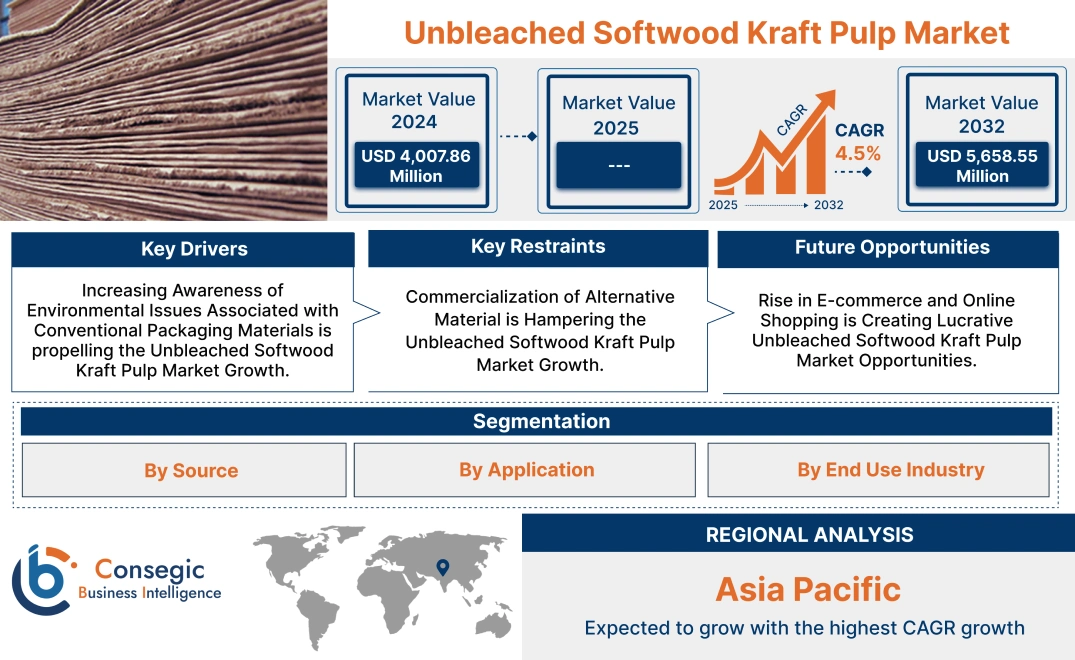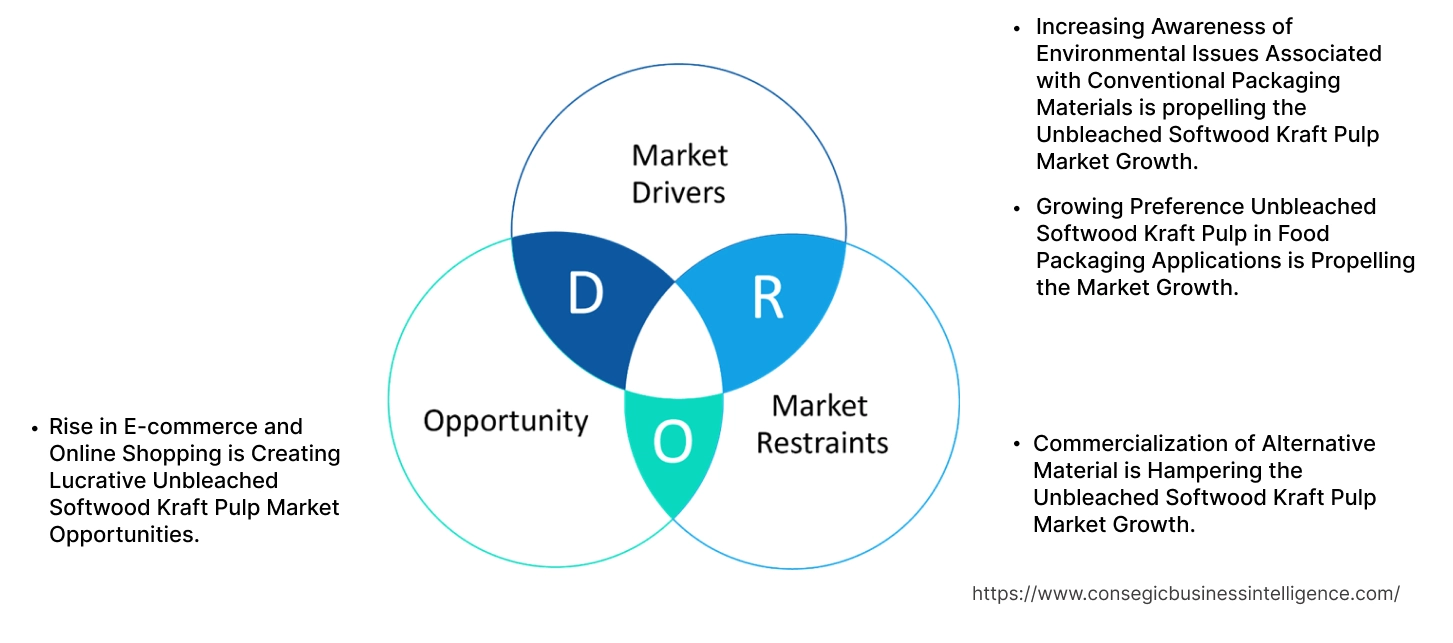- Summary
- Table Of Content
- Methodology
Unbleached Softwood Kraft Pulp Market Size:
Unbleached Softwood Kraft Pulp Market size is growing with a CAGR of 4.5% during the forecast period (2025-2032), and the market is projected to be valued at USD 5,658.55 Million by 2032 from USD 4,007.86 Million in 2024.
Unbleached Softwood Kraft Pulp Market Scope & Overview:
Unbleached Softwood Kraft Pulp (UBK) is a pulp that is derived from sources such as pine spruce and fir among others. The pulp is produced through the kraft process that involves breaking down wood chips into cellulose fibers chemically, while retaining the hemicellulose content and the natural lignin content. The unbleached property gives it a natural brown color which maintains its strength and durability. Additionally, the absence of bleaching reduces the utilization of chemicals which lowers the environmental impact and reduces energy consumption. The application of this pulp generally includes corrugated box, printing paper, tissue & towel, electric insulation paper, cement sacks, filter paper, and others. They are applied in industries including packaging, food & beverages, construction, automotive and others.
Key Drivers:
Increasing Awareness of Environmental Issues Associated with Conventional Packaging Materials is propelling the Unbleached Softwood Kraft Pulp Market Growth.
Conventional packaging materials such as polymers derived from petroleum possess long-lasting detrimental effects on the environment. These materials contribute to greenhouse gas emission. Consumers and businesses are concerned about the environmental effect of these materials that has led to the rise in demand for sustainable and biodegradable packaging materials. Unbleached softwood kraft pulp derived from renewable wood sources, generally offer a sustainable and biodegradable solution, that aligns with the growing requirement of sustainable packaging solutions. Additionally, the rise in the government initiative is creating awareness about the environmental effects of conventional packaging material.
- In July 2022, the Ministry of Environment, Forest and Climate Change, India introduced the ban on single use plastic products to reduce negative use of plastic on the environment. The ban creates awareness about the environmental effects of these products, including conventional packaging material.
Thus, the rise in government initiative for material causing negative effects on the environment influences the use of unbleached softwood kraft pulp for sustainable packaging applications.
Growing Preference Unbleached Softwood Kraft Pulp in Food Packaging Applications is Propelling the Market Growth.
Consumers and businesses are opting for sustainable and eco-friendly packaging solutions for food packaging applications. Unbleached kraft pulp which is derived from renewable wood sources aligns with this preference. It usually offers a biodegradable and recyclable alternative to traditional plastic packaging, which eventually reduces environmental impact. Additionally, the natural brown color of this material enhances the look and authenticity of food products. This appeals to consumers who generally prioritize natural and minimally processed options. Various manufacturers are introducing novel unbeached kraft products that are useful for food packaging applications.
For instance,
- WestRock developed EnduraFiber UKP which is an unbleached kraft pulp. It offers excellent strength properties, including high tensile strength, burst strength, and tear resistance. This pulp meets the government requirements that are essential for food contact packaging.
Thus, this growing consumer preference for sustainable and eco-conscious food packaging is propelling the requirement for unbleached softwood kraft pulp in this sector.
Key Restraints:
Commercialization of Alternative Material is Hampering the Unbleached Softwood Kraft Pulp Market Growth.
Alternative material such as biobased plastics, biopolymers, and bleached softwood kraft papers among others are being developed to promote sustainable and eco-friendly packaging solution. Biobased plastic material such as renewable biomass sources such as starch sugarcane and corn offer advantages such as biodegradability and reduce the reliance on fossil fuels. Biopolymers produced using chitin, chitosan, and cellulose derivatives offers a range of properties that are essential for applications such as packaging and medicine.
Additionally, bleached softwood kraft pulp that are mainly sourced form soft wood are further bleached to remove the lignin to achieve a white color. This material mainly finds its application in specialty papers and printing papers among others. The advantages of these materials mainly in terms of weight, barrier properties, and compostibility among others possess competition to unbleached kraft pulp. Thus, the ongoing development and commercialization of alternative material is hindering the unbleached softwood kraft pulp market expansion.
Future Opportunities :
Rise in E-commerce and Online Shopping is Creating Lucrative Unbleached Softwood Kraft Pulp Market Opportunities.
The growing need for durable, sustainable, and cost-effective packaging material because of the rise in the e-commerce and online shopping is creating opportunities for the market. The rise in the online orders has influenced the requirement of reliable packaging material such as corrugated boxes, which is a primary application of unbleached kraft pulp.
- According to the data published by the India Brand Equity Foundation, in November 2024, states that the e-commerce sector in India attained a rise of 12% in 2024 compared to its previous year.
Hence, the rise in the e-commerce sector influences the use of sustainable packaging material, thus creating lucrative unbleached softwood kraft pulp market opportunities in the coming years
Unbleached Softwood Kraft Pulp Market Segmental Analysis :
By Source:
Based on source, the market is categorized into pine, spruce, and fir among others
Trends in the Source:
- Rise in the trend for uniform fiber structure in influencing the use of spruce as a raw material.
- Growing requirement for long and strong materials for high strength applications.
The pine segment accounted for the largest market share in 2024.
- Conifer trees such as pine offer long and strong fibers, that provide excellent tensile strength and resistance to tear.
- These long fibers contribute to high durability and strength of paper products that are made using pine based kraft pulp, making them suitable for applications such as corrugated boxes, and other heavy duty packaging materials.
- Pine is a readily available and widely distributed softwood species making cost effective and sustainable material for the paper and pulp sector.
- The rapid growth rate of pine trees makes them a sustainable choice for ecofriendly packaging practices.
- For instance, in 2023, Visy, a leading packaging and resource-recovery company, introduced a novel corrugated box manufacturing facility in Hemmant, Queensland, Australia. This USD 175 million investment represents a significant addition to Visy's Australian operations, with the new facility capable of producing up to one million boxes per day.
- Thus, the rise in the development rate and production of pine is influencing the unbleached softwood kraft pulp market trends.
The spruce segment is expected to grow at the fastest CAGR over the forecast period.
- Spruce is widely known because of its uniform fiber structure and balanced strength-to-weight ratio, which is important for various packaging applications.
- This material exhibits excellent properties such as tensile strength, resistance to tear and burst strength.
- These properties make spruce-derived kraft pulp ideal for applications such as corrugated packaging, paperboard, and linerboard among others, which require high strength and durability.
- Additionally, spruce is a readily available and renewable resource in many regions, making it a sustainable raw material for packaging applications.
- Thus, the rise in the development and utilization of spruces is driving Unbleached softwood kraft pulp industry
By Application:
Based on applications, the market is categorized into corrugated box, printing paper, tissue & towel, electric insulation paper, cement sacks, filter paper, and others.
Trends in Application:
- The growing trend for tissue and towels for personal care applications.
- Rise in the trend for filter paper for medical applications
The corrugated box segment accounted for the largest Unbleached softwood kraft pulp market share of 47.65% in the year 2024.
- Unbleached softwood kraft pulp finds its significant application in the production of corrugated boxes,
- These boxes are widely used in modern logistics and e-commerce providing essential protection for goods for storage and transportation.
- The properties such as high tensile strength, stiffness and burst strength of unbleached kraft pulp make them an ideal raw material for durable and strong corrugated boxes.
- This material effectively safeguards products during transit, which minimizes the damage and ensures safe delivery to the consumers.
- This rise in the manufacturing of these materials influences the use of UBK.
- For instance, according to the data published by the Fibrebox organization, states that U.S. corrugated manufacturing contributes to USD 24.7 billion to the GDP of America.
- Thus, the application of this pulp in corrugated boxes is influencing the unbleached softwood kraft pulp market trends.
The tissue & towel segment is expected to grow at the fastest CAGR over the forecast period.
- Unbleached softwood pulp is used as a raw material in the production of tissue and towel as it provides a good balance of absorbency and strength.
- The natural fiber present in this material has a soft texture and offers properties such as strength, durability and resistance to tear during use.
- These tissues and towels are eco-friendly and align with the growing requirement for sustainable paper products.
- Many consumers prefer natural and unbleached tissue and towel products because of their environmental benefits, leading to an increase in requirement for such products.
- Thus, based on the market analysis, the rise in the use of unbleached kraft pulp is influencing the unbleached softwood kraft pulp market expansion.
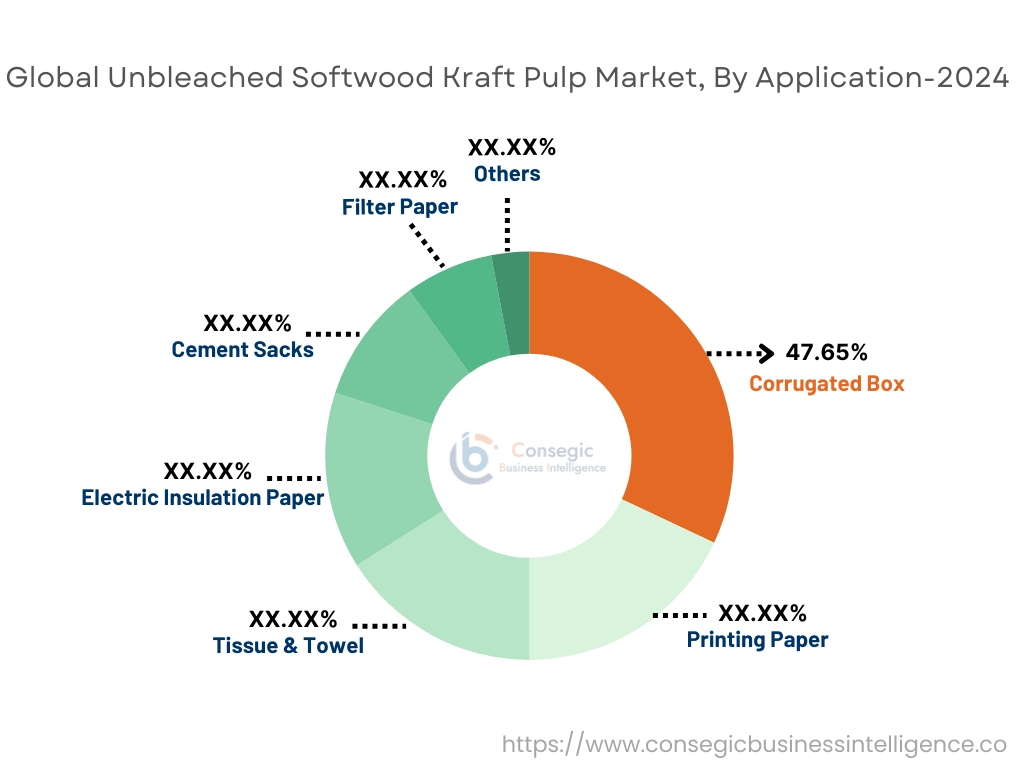
By End Use Industry:
Based on end use industry, the market is categorized into packaging, food & beverages, construction, automotive, and others
Trends in the End Use Industry:
- The growing trend for renewable energy and electronic devices is influencing the requirement of electric insulation paper in the electronics sector.
- Rise in the awareness of personal hygiene is influencing the personal care sector
The packaging segment accounted for the largest market share in the year 2024.
- The packaging sector is a significant end-use sector of the market.
- Corrugated boxes are essential materials used in the packaging sector.
- Unbleached kraft pulp provides enhanced strength and durability that is required for the key components of the corrugated box which consists of linerboard and medium.
- It offers high tensile strength, stiffness and burst resistance, that enables the production of reliable packaging solutions that easily withstand harsh effects caused during transport.
- The rise in the packaging sector is influencing the use of sustainable materials such as unbleached softwood pulp.
- For instance, according to the data published by PIAI, states that packaging sector is among the highest growing sector in India which is developing at 22% to 25% per annum.
- Thus, based on market analysis, the rise in the packaging sector is influencing the unbleached softwood kraft pulp market demand.
The others segment is expected to grow at the fastest CAGR over the forecast period.
- The others segment consists of the personal care sector, electrical and electronic sector, and others
- Unbleached softwood kraft pulp is used in the production of towels & tissues that are essential for personal care application.
- The high absorbency of this material makes it essential for the production of tissues & towels.
- Additionally, in the electronic industry, this material is utilized in the production of electric insulation paper which is essential as it is used as an insulator in high voltage electric equipment such as transformers, capacitors, and power cables.
- They are used in the production of these papers mainly because of their strength and dielectric properties, which are essential in the electronics sector.
- Thus, based on the market analysis, the development of the personal care and electronics sector among others is influencing the market expansion.
Regional Analysis:
The regional segment includes North America, Europe, Asia Pacific, the Middle East and Africa, and Latin America.
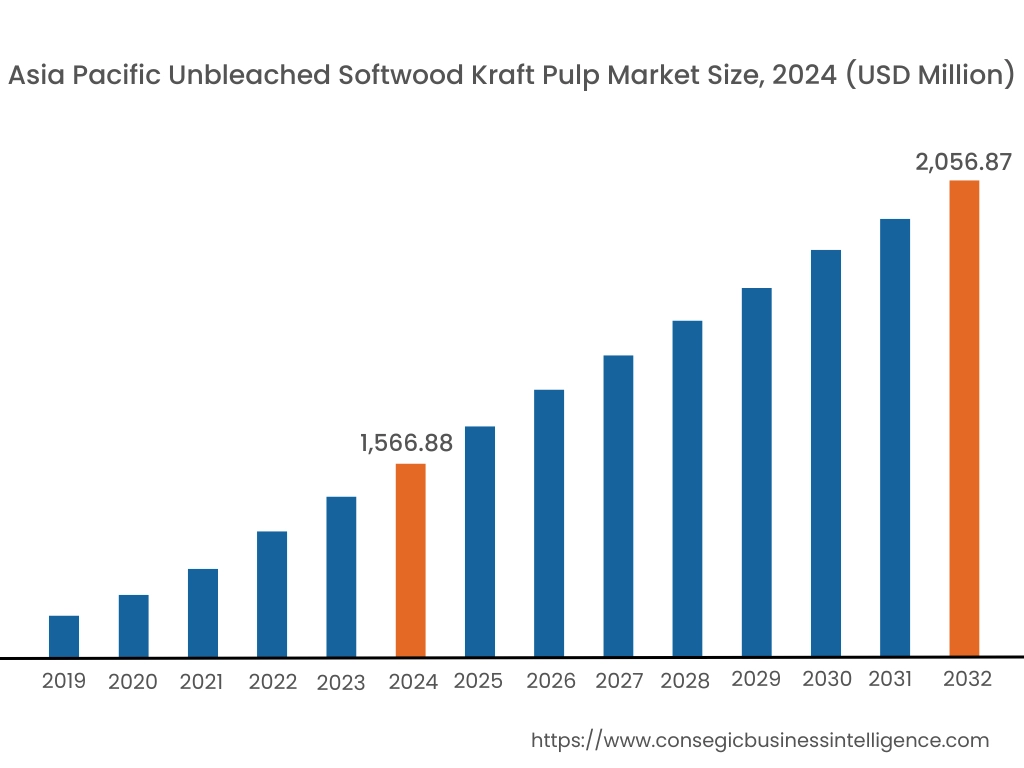
In 2024, Asia Pacific accounted for the highest market share at 39.1% and was valued at USD 1,566.88 Million and is expected to reach USD 2,056.87 Million in 2032. In Asia Pacific, China accounted for the highest market share of 34.72% during the base year of 2024.
Significant economic growth in the Asian countries, mainly in China and India are driving the consumer spending and industrial activities, that leads to the rise in demand for various packaging material. Additionally, the region has a large and growing population, which leads to a rise in demand for consumer goods and further for packaging materials that are essential in transport and protecting them. The rise in the consumption packaging of paper is influencing the use of sustainable material.
For instance,
- According to the data published by the India Brand Equity Foundation, states that the domestic consumption of paperboard and packaging paper is growing at 8.2% in 2023-2024.
Asia Pacific is becoming increasingly aware of the environmental issue and harmful impact of plastic pollution. Governments across the region are implementing stricter regulations regarding plastic waste and promoting greener alternatives. Thus, awareness and government initiatives are driving the development of the market.
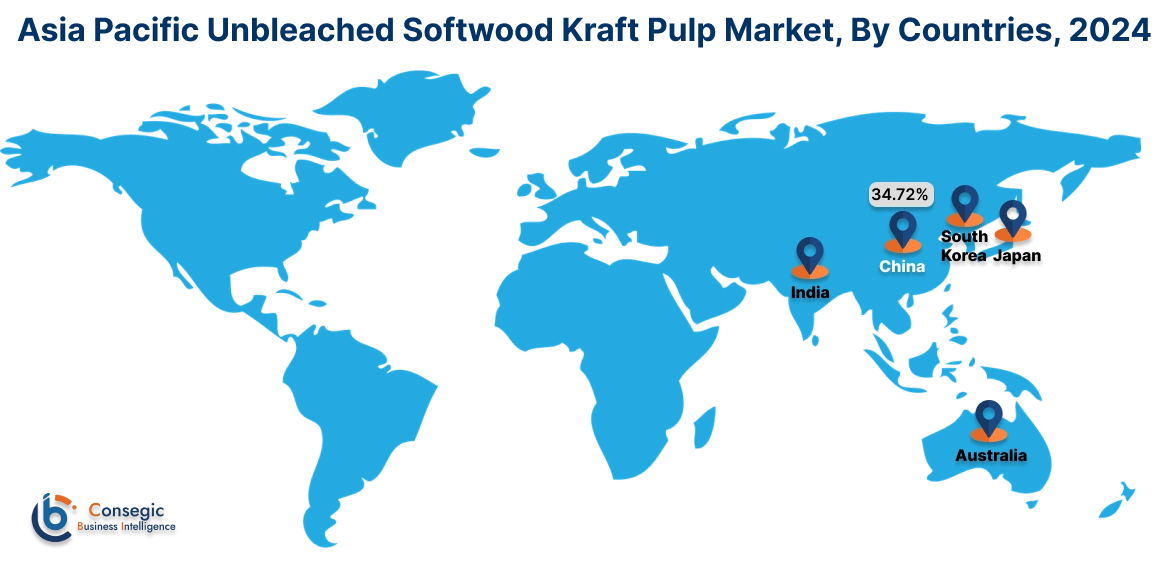
Europe is experiencing the fastest growth with a CAGR of 6.2% over the forecast period. Europe presents a significant contribution to the Unbleached Softwood Kraft Pulp market analysis. Europe consists of a well-developed packaging sector, which has a strong emphasis on the development of new products and technologies. European consumers and businesses are well aware of the environmental issues. This has led to the rise in the requirement of sustainable solutions that are mainly produced using unbleached kraft pulp sourced from sustainably managed forests. Europe has stringent environmental regulations that influence the use of sustainable and eco-friendly materials, encouraging the use of unbleached softwood pulp. Additionally, the development of the electronic sector drives the use of this material in the packaging and insulation of electronic components. Thus, the aforementioned factors are influencing the development of the market.
The North America region consists of vast forest resources, which generally provides raw materials such as pine and fir for the production of pulp. The strong emphasis on the e-commerce sector has fueled the requirement for sustainable packaging material that is essential for applications such as corrugated boxes. Additionally, a rise in awareness has led to the requirement of sustainable materials and eco-friendly packaging solutions. Companies in the North America region are incorporating sustainable forestry practices and investing in technologies that improve the environmental performance of pulp mills. Thus, based on the unbleached softwood kraft pulp market analysis, the rise in the use of sustainable packaging material is propelling the market development.
The Middle East and Africa (MEA) regions are witnessing notable Unbleached Softwood Kraft Pulp market demand characterized by significant potential. The rise in the population and urbanization in several parts of the region are driving the requirement for consumer goods, which leads to the rise in the utilization of for packaging materials. The economic development in this region has fueled industrial development and consumer spending, which leads to the requirement of packaging materials. Additionally, the ongoing infrastructure development activities are influencing the use of various construction material such as cement that are generally stored and transported in cement sacks that is one of the primary applications of unbleached softwood pulp. Thus, these aforementioned factors are influencing the development of the market in this region.
Latin America is an emerging region in the Unbleached Softwood Kraft Pulp market share, with significant potential for innovation. The Latin American automotive sector is experiencing a significant trajectory, driven by increasing disposable incomes, government initiatives, and rising requirements for personal mobility. This trend has led to a corresponding increase in the need for packaging materials. Additionally, rapid urbanization and infrastructure development are driving the need for efficient transportation solutions including sustainable packaging solutions. This analysis presents a substantial potential for automotive packaging manufacturers and suppliers to capitalize on this burgeoning market and contribute to the region's market demand.
Top Key Players and Market Share Insights:
The global Unbleached Softwood Kraft Pulp market is highly competitive with major players providing precise products to the national and international markets. Key players are adopting several strategies in research and development (R&D) and product innovation to hold a strong position in the global Unbleached Softwood Kraft Pulp market. Key players in the Unbleached Softwood Kraft Pulp industry include-
- Canfor (Canada)
- Stora Enso (Finland)
- Smurfit Kappa (Ireland)
- Fibre Excellence (France)
- Toyota Tsusho Matex Corporation (Japan)
- North American Cellulose (United States)
- Paper Excellence(Canada)
- WestRock Company. (United States)
- Ilim Group (Russia)
- Mondi Group (Austria)
Unbleached Softwood Kraft Pulp Market Report Insights :
| Report Attributes | Report Details |
| Study Timeline | 2019-2032 |
| Market Size in 2032 | USD 5,658.55 Million |
| CAGR (2025-2032) | 4.5% |
| By Source |
|
| By Application |
|
| By End Use Industry |
|
| By Region |
|
| Key Players |
|
| North America | U.S. Canada Mexico |
| Europe | U.K. Germany France Spain Italy Russia Benelux Rest of Europe |
| APAC | China South Korea Japan India Australia ASEAN Rest of Asia-Pacific |
| Middle East and Africa | GCC Turkey South Africa Rest of MEA |
| LATAM | Brazil Argentina Chile Rest of LATAM |
| Report Coverage |
|
Key Questions Answered in the Report
How big is the Unbleached Softwood Kraft Pulp market? +
In 2024, the Unbleached Softwood Kraft Pulp market is USD 4,007.86 Million.
Which is the fastest-growing region in the Unbleached Softwood Kraft Pulp market? +
Europe is the fastest-growing region in the Unbleached Softwood Kraft Pulp market.
What specific segmentation details are covered in the Unbleached Softwood Kraft Pulp market? +
Source, Application and End Use Industry segmentation details are covered in the Unbleached Softwood Kraft Pulp market.
Who are the major players in the Unbleached Softwood Kraft Pulp market? +
Canfor (Canada), Stora Enso (Finland), and North American Cellulose (United States) are some of the major players in the market.
